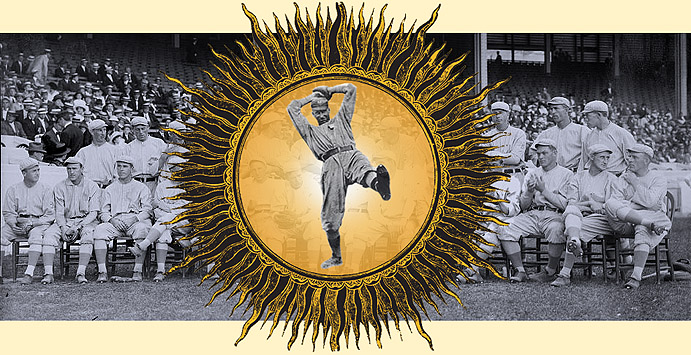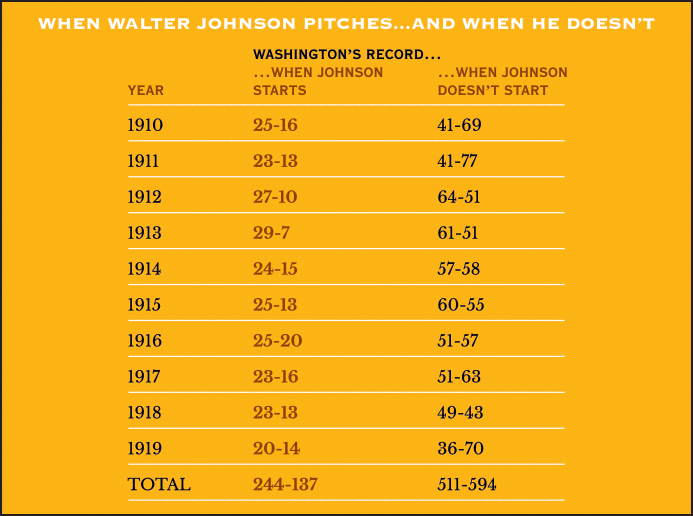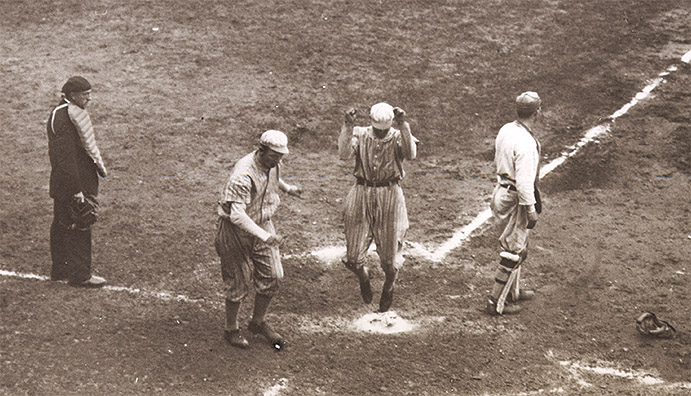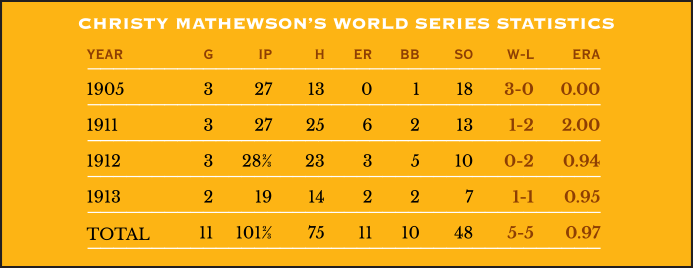THE YEARLY READER
1913: Giant Bridesmaids Again
Despite their reputation as one of baseball’s most heralded teams, the New York Giants continue to find complete frustration at the World Series, while major league owners otherwise keep a weary eye on an upstart third circuit, the Federal League.

He came to the Polo Grounds one day in 1911, armed with a fortune teller’s promise of good luck for John McGraw and his New York Giants. But only if he pitched.
Unlike his namesake from medieval literature, Charles Faust (shown above) wasn’t selling his soul to the devil to get a spot on the Giants, but rather was coming to McGraw almost as the devil himself. And while the normally irascible McGraw found enough sense of humor in Faust’s uninvited presence to give him a tryout—where McGraw discovered no special talent—he was put on the roster anyway. Not to pitch, but to sit on the bench as a good luck charm.
Faust was employed on-and-off through the next two years as a human rabbit’s foot, needed only went the Giants were rubbing for a winning streak. He proved so successful, the team nicknamed him “Victory,” and even gave him the chance to pitch at the end of 1911—allowing a run on two hits over two innings.
But when it came to the World Series, Faust brought no luck to New York—as proven by two consecutive Series defeats entering 1913. Still, McGraw gave Faust his seat on the bench, albeit less frequently.
By 1913, the Giants had such a handle on National League competition, there seemed little need for a good luck charm in the dugout. Only minor tinkering was done to the roster in sporting another try at the top, as their everyday lineup stayed pat save for the inclusion of 23-year-old outfielder George Burns. From top to bottom, the Giants were a remarkable constant of efficiency; though leading the NL in team batting, individually they hardly dented the league’s offensive leaderboards. Every regular batted somewhere between .261 and .297, hit somewhere between two and five home runs, and stole somewhere between 22 and 40 bases. There were no superstars—nor holes—to be found in the Giants batting order.
Whereas everybody chipped in on offense, the Giants’ pitching staff was impressively anchored by a genuine legend and two other hurlers at the top of their game. Together, Christy Mathewson, Rube Marquard and Jeff Tesreau ganged up to overwhelm the competition, and their efforts easily gave the Giants the league’s best earned run average, at 2.43.
Once a strikeout king, Mathewson began relying more on finesse—and walked just 21 batters in 306 innings during the year. Included in those numbers: A string of 68 consecutive innings without yielding a walk to set an all-time record among starting pitchers.
BTW: Randy Jones tied Mathewson’s record among starters in 1976; Greg Maddux broke it in 2001.
The National League race remained close, but for only half a season. The Chicago Cubs, with Johnny Evers replacing Frank Chance as manager, started off well but faded, facing reality as a team in transition. The Phillies, a team truly on the rise, made the last serious stab at yanking first place loose from the Giants. Powered by pitchers Tom Seaton (a league-high 27 wins), Pete Alexander (22-8), and aided by Gavvy Cravath’s major league-leading 19 home runs and 128 runs batted in, the Phillies stayed atop the standings through the end of June.
That’s when the Giants came to the Baker Bowl and wrestled first place away. The series ended with manager John McGraw taking center stage; after challenging Philadelphia pitcher Ad Brennan to a fight, the two met up on the field—where Brennan was joined by a horde of Phillies fans. McGraw took his punches but somehow survived, again setting the tone for his team’s fighting spirit. It was classic rogue McGraw; the Giants never looked back from that moment on, distancing themselves from the Phillies and winning their third straight NL pennant, and their fifth in 10 years under McGraw.
After slipping to third place in 1912, the Philadelphia Athletics climbed back to collect their third American League pennant in four years. In doing so, manager Connie Mack had to mix up his pitching staff with a batch of very green prospects.
He couldn’t have been more pleased with the results.
Mack had his elders in the rotation in Eddie Plank and Chief Bender, and they continued to produce for him. But Mack lost former 30-game winner Jack Coombs to a season-long back injury, and he released Cy Morgan, whose one-time solid skills had suddenly eroded to nothing.
In forcing several of his younger pitchers to step up to the mound, Mack got great returns from 22-year-old Bob Shawkey (an 8-5 record and 2.35 ERA in 18 appearances), 21-year-old Duke Houck and 20-year-old Bullet Joe Bush (both 14-6). To accentuate the achievement of his young cadets, Mack brought up 19-year-old future Hall of Famer Herb Pennock to start and win the game that iced the AL pennant for the Athletics in late September.
Mack played the relief game more, perhaps by design. No other team in the majors completed fewer games than the A’s, who had 69. Chief Bender epitomized the shared duties of the A’s staff; he started only 21 games, but also won 21, many of which were earned through 27 relief appearances. He saved a league-high 13 games.
Philadelphia’s hitting was simply no match for the rest of the AL, leading the league in almost every offensive category. The “$100,000 Infield” was worth almost every penny at the plate, with three of its four members—Eddie Collins, Home Run Baker and Stuffy McInnis—respectively placing fourth, fifth and seventh in the AL batting race. Baker continued to live up to his nickname, leading the league in home runs for the third straight year. The A’s also got a youthful shot in the arm in the outfield—for years, the team’s relative weakness—with 21-year-old Eddie Murphy (.295, 105 runs) taking over in right.
The A’s led for almost the entire season, but couldn’t leapfrog away from their closest competitors. Washington’s Walter Johnson, arguably the greatest pitcher ever to stand atop a mound, unarguably had his best year ever. With a 36-7 record, 1.14 ERA and 11 shutouts, Johnson’s staggering display was again the lone reason for Washington’s second-place standing; without him, the Senators were just another .500 team. As it was, Johnson propelled the club to within 6.5 games of the A’s at the finish.
No Walter, Will Falter
If ever a pitcher meant something to his team, it was Walter Johnson to the Washington Senators during the 1910s. When the Big Train got the decision—usually, it was a victory—the Senators were kings. His off-days, however, transformed the team into just another ho-hum squad struggling to play .500 ball.

Perhaps more startling was the descent of the defending world champion Boston Red Sox. Smoky Joe Wood, the man with the 34-5 record the year before, suffered a broken finger in spring training and couldn’t recapture his superhuman ways upon recovery. The rest of the pitching staff couldn’t step it up, and the hitting went flat. The fingers of blame were officially pointed at Jake Stahl, fired after a 39-41 start. The Sox wound up in fourth place.
Squaring off against one another in the World Series for the third time in nine years, the Athletics were labeled with the underdog tag against the Giants, winners of 101 games. Yet once more, the Fall Classic would prove a frustrating adventure for John McGraw.
Chucking away his policy of relief, Connie Mack stayed with his starters in every game, and for good reason. The A’s used just three hurlers—Chief Bender, Eddie Plank and Bullet Joe Bush—throughout the entire series, holding the Giants to a .201 batting average. At the plate, Home Run Baker continued to be the majors’ first incarnation of Mr. October, batting .450 with yet another round-tripper. The combination of strong pitching and timely hitting gave Philadelphia an easy World Series triumph in five games.

Buck Herzog scores one of three 10th-inning runs for the Giants in Game Two of the World Series. It would be their only hurrah against the Athletics. (The Rucker Archive)
Injuries hurt the Giants from the start. Fred Snodgrass, the championed goat of the 1912 Series, saw very limited duty due to a leg injury. Catcher Chief Meyers was lost after Game One with an injured finger.
Christy Mathewson’s last appearance in a World Series would be bittersweet. Though helping the Giants to avoid a sweep by hurling a 10-inning shutout in Game Two, he lost the Game Five clincher via a familiar theme: Lack of support.
For John McGraw, the Series loss was another blow to his Giants—and perhaps more pointedly, his ego—from the circuit he once called “minor league,” a league that had once booted him out for his thug-like attitude toward umpires. A league that was now accelerating through a decade of near-domination over its elder sibling.
Bittersweet Smell of Partial Success
Christy Mathewson may have won 373 career regular season games, but collecting World Series victories proved far more elusive—despite a 0.97 postseason ERA. Part of the problem: His team couldn’t hit. The Giants batted .199 when he started in the Fall Classic and scored only eight runs in his five losses.

Charles “Victory” Faust’s presence probably wouldn’t have mattered. McGraw had let his lucky charm go during the season, never to return. The next year, Faust was admitted into an insane asylum in the Pacific Northwest, where he would die at the age of 34.
While the AL enjoyed the power it had aimed for 13 years earlier—when it elbowed its way onto the major league scene—it now braced for the arrival of another brash new outfit to give it and the NL stiff competition: The Federal League.
Formed early in 1913 and initially well-financed, the Federal League took a page out of the AL’s book in gaining major league status: By playing a season of minor league ball in Midwest cities, then expanding to the East coast and declaring itself a major circuit, raiding the established leagues for talent.
When the Feds (as they were informally known) announced shortly after the 1913 season that they would not honor the reserve clause, the players who had been financially handcuffed for years suddenly saw the market for supply and demand turn sharply in their favor. Many began signing on with the FL for its inaugural 1914 major league campaign: Three Finger Brown, Hal Chase, George Mullin, Edd Roush, Joe Tinker and Ed Reulbach were among the big names who jumped. Stories circulated of Ty Cobb, Tris Speaker and John McGraw being offered six-figure salaries—a staggering amount of money for its day—to join the Feds’ ranks. Neither of them came, opting to stick with the establishment rather then venture into the riches of the unknown and unproven.
Walter Johnson would eventually go as far as to sign with the Chicago ChiFeds—he even received an advance—but soon after got cold feet and allowed Senators owner Clark Griffith to match the offer. Never a big spender, Griffith came up with the cash only when White Sox owner Charles Comiskey, dreading the idea of local competition from a team featuring Johnson, helped ante up to keep the Big Train stationed in Washington.
Though the Feds were staking out unclaimed territory in Indianapolis, Buffalo and Kansas City, the other five teams would be sharing city space with NL and AL counterparts. Fans in Chicago and St. Louis now had three major league teams to choose from; in New York City, they had four to check out.
If fans in Baseball America now had their hands full with whom to follow, the owners within the three major leagues had theirs full as well—with what to do with all the fierce competition.
 Forward to 1914: The Miracle Braves Cellar-bound in July, the usually hapless Boston Braves perform one of the game’s greatest turnarounds.
Forward to 1914: The Miracle Braves Cellar-bound in July, the usually hapless Boston Braves perform one of the game’s greatest turnarounds.
 Back to 1912: The $30,000 Muffs Frank Baker famously powers the Philadelphia Athletics past an aggressive New York Giants squad in the World Series.
Back to 1912: The $30,000 Muffs Frank Baker famously powers the Philadelphia Athletics past an aggressive New York Giants squad in the World Series.
 1913 Leaders & Honors Our list of baseball’s top 10 hitters and pitchers in both the American League and National League for the 1913 baseball season, as well as the awards and honors given to the game’s top achievers of the year.
1913 Leaders & Honors Our list of baseball’s top 10 hitters and pitchers in both the American League and National League for the 1913 baseball season, as well as the awards and honors given to the game’s top achievers of the year.
 The 1910s: The Feds, the Fight and the Fix The majors suffer growing pains as they deal with a fledgling third league, increased scandal and gambling problems, and a brief interruption from the Great War.
The 1910s: The Feds, the Fight and the Fix The majors suffer growing pains as they deal with a fledgling third league, increased scandal and gambling problems, and a brief interruption from the Great War.





